Termite Pictures – Images of Infestation
Understanding the Challenge: Termites in disguise & identifying what they look like.
Indeed, when it comes to protecting your home from these destructive pests, the number one challenge is…
Differentiating between various types of termites and identifying key features and signs of termite infestation.
You might think you’re dealing with harmless ants or confuse subterranean termites with dampwood termites, & before you know it – you’ve got a full-blown termite problem on your hands!
Why Termite Identification is Vital
Without an in-depth knowledge of these wood eating pests’ unique traits, safeguarding our homes remains an uphill battle.
Key Features of Termites
- Subterranean Termites: Commonly found in moist environments and are known to build distinctive “mud tubes” for travel.
- Dampwood Termites: Prefer wood with higher moisture content and can often be found in damp, decaying wood.
- Drywood Termites: They thrive in dry conditions and don’t require contact with the soil.
Effective Termite Protection Strategies
To ensure the safety of our homes, it’s essential to:
- Recognize the various termite species -Familiarizing yourself with different termites and what they look like is crucial
- Understand their behavioral patterns.
- Implement preventive measures based on their specific characteristics.
Table of Contents:
- The Destructive Nature of Termites
- An Overview of Common Termite Species
- Signs of a Termite Infestation
- Understanding Termite Castes
- Professional Termite Control Measures
- Preventing Future Infestations
- FAQs in Relation to Different Termites and What They Look Like
The Destructive Nature of Termites
Termites, these minuscule creatures are a homeowner’s worst enemy. Termites cause approximately five billion dollars in damage to properties throughout the US annually.
Around 2,000 known termite species exist worldwide and understanding their unique behaviors is critical to early detection of infestations. The sooner you spot termites on your property, the better chance you have at preventing extensive damage they can cause.
Different types of termites pose varying threats due to their distinctive habits and habitats. Some thrive in damp conditions while others prefer dry environments; some live underground whereas others inhabit wooden structures directly – all factors that contribute towards identifying common termite species.
Why Early Detection Matters
The real danger with termites lies not just in their ability to chew through wood but also how silently they do it. By the time visible signs such as hollowed-out wood or mud tubes appear, significant structural damage might already be done.
This makes early detection crucial for homeowners who want to protect their investment from these destructive pests. Regular inspections by professionals can help uncover hidden termite activity before it escalates into full-blown infestation like those caused by subterranean termites or Formosan workers.
The Economic Impact of Termite Damage
Beyond personal distress and inconvenience caused by a termite invasion there’s considerable economic impact involved too – both on individual homeowners as well as the broader economy alike. In fact, U.S homeowners spend billions annually repairing damages caused solely by this pest alone. This includes costs associated with professional extermination services and repair work needed post-infestation, which often involves replacing structurally compromised beams and other elements within affected buildings’ framework – no small expense indeed.
A Global Pest Problem
While we’ve focused largely on American homes thus far, given our target audience comprises primarily US-based readership, let us remember: the issue extends beyond domestic borders. Termites are found all over the world, causing similar havoc wherever they settle down. From Asia, Africa, Europe, South America, Australia – virtually every continent has its share of troublesome insect invaders wreaking havoc on local ecosystems and human habitations alike. So if you think you’re safe simply because you don’t reside stateside, guess again – chances are good you could still face an unwelcome visit from these critters someday soon.
Key Takeaway:
Termites, with 2,000 species globally, are silent destroyers causing $5 billion in annual US property damage. Early detection is key to thwarting these pests that favor varied habitats and can cause extensive structural harm before visible signs appear. Their economic impact extends beyond personal distress to significant repair costs post-infestation – a global issue not confined within American borders.
An Overview of Common Termite Species
Termites, those pesky destroyers of wooden structures, come in a variety. Each species boasts unique traits and behaviors that can spell disaster for homeowners if left unchecked.
Subterranean Termites
The most destructive termite species found across the U.S., subterranean termites live their lives underground within expansive colonies. These critters have an affinity for moisture-rich environments and wood that comes into contact with soil—making your home’s foundation a prime target.
In essence, these pests cause significant damage by creating mud tubes; a protective tunnel system from their nest to food sources such as your house’s framework or furniture. Further information on eastern subterranean termites is available here.
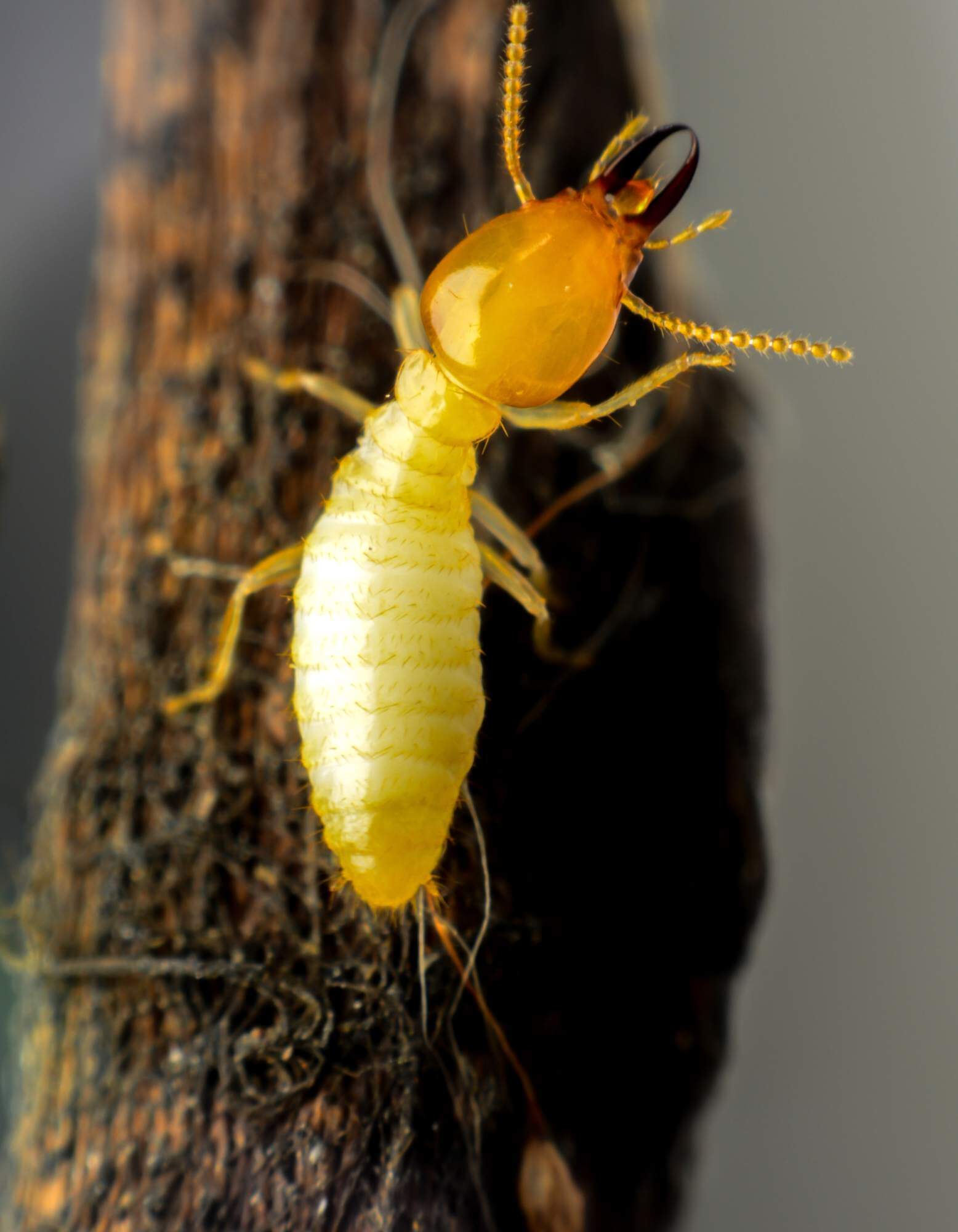
A soft bodied subterranean termite walking on wood.
Formosan Termites
A subtype of the Subterranean category; Formosan workers and soldiers form some colossal colonies compared to other termite types. Their aggressive nature coupled with voracious appetite make them formidable foes when it comes down dealing effectively through traditional means like baiting systems designed primarily around exploiting water needs commonly seen amongst majority pest varieties out there today. For more insights about Formosan soldier behavior click here. It’s important to know that unlike many other insects, both male and female termites that can reproduce exist. This plays a big role in their fast growth. This is why it’s really important to understand the differences between these different types when you first identify them. This helps before you start any treatment plan to get rid of them completely. By doing this, you can lower the chances of them coming back again in the future.
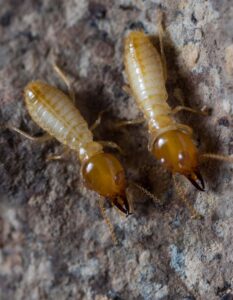
Two formosan worker termites side by side.
Drywood Termites
Drywood termites infest dry wood instead requiring contact moist areas damp counterparts do typically targeting furniture structural timbers inside homes Southeastern specifically prefer much drier conditions than kinds making them particularly troublesome. More detailed analysis southeastern Southeastern Drywood Termites check out article.
To sum it up, it’s better to prevent problems rather than deal with them later. So, taking action ahead of time is important to avoid big troubles caused by various types of termites like Dampwoods, Coneheads, Soldiers, and Workers. One way to do this is by sealing up cracks in foundations, if you can. Also, it’s a good idea to lower the amount of wood around buildings. These steps can keep termites away in the long term and also save you lots of money that you’d otherwise spend on fixing damages.
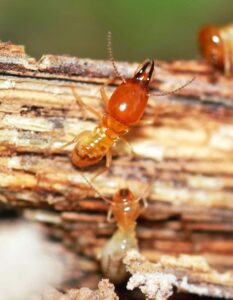
Different staged drywood termites on rotted wood.
Key Takeaway:
Termites, whether they’re subterranean, Formosan or drywood species, can wreak havoc on your home. Subterraneans tunnel from soil to wood; Formosans form massive colonies and have a fierce appetite for destruction; while drywoods prefer drier conditions and infest furniture. Spotting their differences is crucial in implementing effective prevention strategies.
Signs of a Termite Infestation
Be vigilant, for termite destruction can go undetected until it’s too late. But fear not. Recognizing signs of termite activity early on is your best defense against these destructive pests.
Flying or swarming termites are one clear indicator that you might have an unwelcome colony nearby. These winged invaders take flight in search of mates and new colonies – so if they’re inside your home, there’s likely a well-established nest close by.
Swarms: The Telltale Sign Of An Active Colony
The sight of flying ants leaving established colonies during mating season – usually occurring during warm months after rainfalls – isn’t just unnerving; it also indicates both existing mature colonies and potentially new ones forming elsewhere if left unchecked.
Mud shelter tubes provide another clue for subterranean species like eastern subterranean termites and Formosan workers who use them as protective pathways connecting soil-based nests with above-ground food sources. Here’s more information about how mud tubes function.
Mud Tubes: Pathways to Destruction for Subterranean Termites
If you spot earthen tunnels along foundation walls or other structures, be warned – this could mean trouble from underground dwellers such as Formosan subterranean termites.
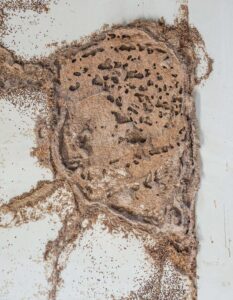
Advanced termite created mud tubes on side of residential home.
Damaged Wood: A Silent Warning from Destructive Pests
Last but certainly not least, wood damage may indicate termite infestations. This could range from hollow-sounding timber when tapped to visible destruction resembling grain patterns within wooden materials—this specifically points towards drywood termite presence. Check out this article explaining what kind damages each type causes depending where they live (drywood vs dampwood vs subterranian) along some useful tips detecting hidden damages at early stages yourself before calling professionals thorough inspections. Remember regular checks save homeowners significant repair costs down line.
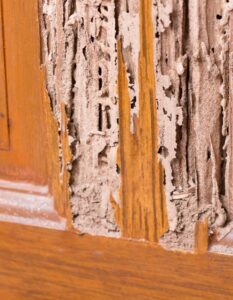
Damaged cabinet wood inside residential home.
Key Takeaway:
Stay ahead of termite troubles by knowing the signs: swarming termites, mud shelter tubes, and wood damage are red flags. Regular checks can save you a fortune in repairs. Remember, prevention is key – keep moisture low and seal cracks to deter these destructive pests.
Understanding Termite Castes
The world of termites is an intricate one, with each termite playing a specific role within their colony. The social structure consists of different castes – queens, kings, reproductive termites (also known as alates), workers, and soldiers. Each caste contributes to the survival and growth of the entire colony.
Worker Termites
If you’ve ever wondered who does all the hard work in a termite colony, it’s these guys – worker termites. They are responsible for feeding every other member in the nest from larvae to nymphs; even those high-ranking ones like soldiers or reproductives don’t get spared.
In addition to being on food duty 24/7, they’re also tasked with construction jobs such as building tunnels or galleries that allow easy movement throughout nests, which often results in severe structural damage if not detected early enough.
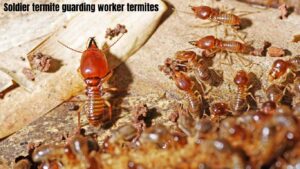
Soldier termite guarding worker termites.
Soldier Termites
Moving onto soldier termites whose main job description involves defending colonies against threats posed by predators like ants or beetles using their large mandibles effectively while blocking entry points into galleries when under attack.
Apart from having powerful jaws, some species have long snouts capable of spraying toxic chemicals at enemies, ensuring uninterrupted of essential tasks by worker counterparts.
Professional Termite Control Measures
The reality of termite infestations is that they’re not a do-it-yourself project. The complex life cycle and colony structure of termites necessitate the expertise of pest control professionals.
Pest management experts have specialized knowledge and tools to detect, identify, assess the extent of an infestation, and apply effective treatments tailored for each case. They can also spot potential risk areas where future invasions might occur – prevention being better than cure. Termite control strategies include soil treatment, wood treatment, or baiting systems depending on what best suits your situation.
Soil Treatment: A Shield Against Subterranean Termites
If you are dealing with subterranean species like Formosan subterranean termites which build extensive colonies underground then soil treatments could be part of their strategy. This involves creating a chemical barrier around your home’s foundation to deter entry by these damaging insects.
This method requires precision in application techniques ensuring complete coverage – something only trained technicians understand given their understanding how different termite species behave interact within the environment.
Baiting Systems: Slow but Sure Eradication Method
Bait stations filled with cellulose material (food source) combined with slow-acting poison placed perimeter property form another tool used especially controlling both drywood types such as Southeastern Drywood variety workers from colony ingest this poisoned food share it among members leading eventual death entire over time making highly effective even those hidden deep inside wooden structures beneath ground level hard reach otherwise.
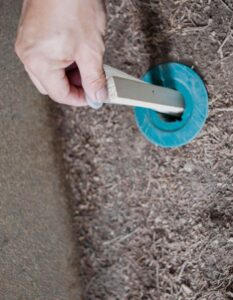
Bait station being filled with pellets to complete termite eradication.
Fumigation Process: Last Resort for Severe Cases
In severe cases, particularly when dampwood or drywood varieties are involved, whole-house fumigation might be a necessary solution. During the process, the house is tented and sealed before toxic gas is released, which penetrates walls and furniture to kill all stages of the lifecycle present there. Afterwards, it is ventilated to allow the remaining gas to dissipate, ensuring safe re-entry for occupants. However, despite its potency, it should always be the last resort due to the high cost and inconvenience for homeowners. Plus, it doesn’t provide any residual protection against future invasions, unlike other methods mentioned above. Thus, regular inspections remain a vital component of an overall prevention plan, regardless of the chosen course of action.
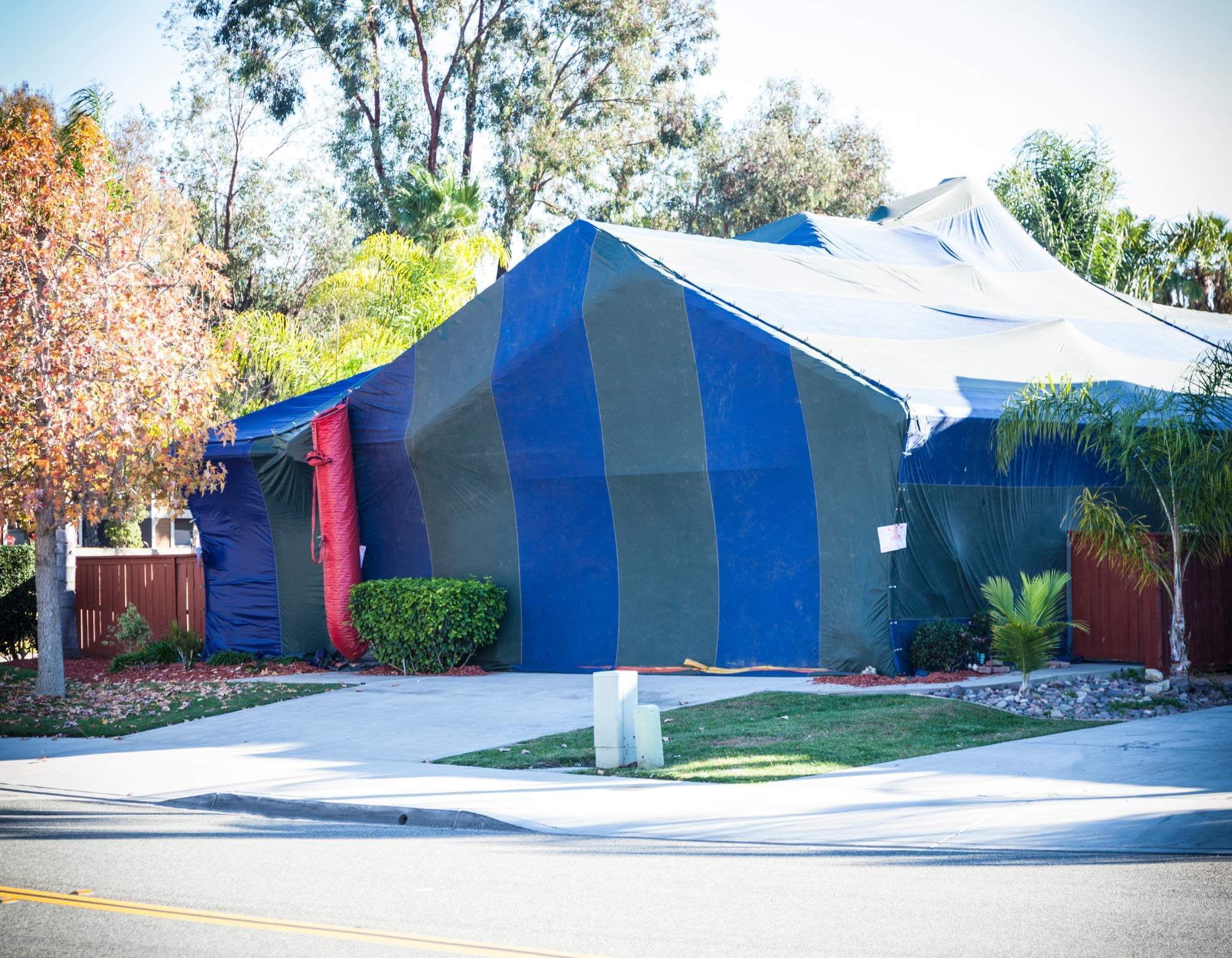
Tented residential home being fumigated for termite infestation.
Key Takeaway:
Termites aren’t a DIY issue. Professionals, armed with specialized knowledge and tools, are needed to identify infestations and apply effective treatments. Strategies can include soil treatment for subterranean species, baiting systems for drywood types or even fumigation in severe cases. Regular inspections remain crucial regardless of the chosen action plan.
Preventing Future Infestations
The bane of homeownership, termites. These pests are notorious for their destructive tendencies when it comes to wooden structures in your home. Do not despair – there are ways to protect your home from termites. You can take proactive measures to keep these invaders at bay.
In essence, moisture-rich environments and wood are like magnets for termite species such as subterranean or Formosan workers. By reducing moisture levels around wooden structures in your house you could deter potential infestation.
Maintaining Your Yard: A Proactive Approach
Your yard maintenance habits play an integral role too; cleaning up fallen trees branches or dead plants prevents rotting wood from becoming a food source particularly appealing to eastern subterranean termites (University of Kentucky College of Agriculture).
- Avoid stacking firewood against house walls – this provides easy access points into the interior structure where drywood termites live.
- Instead stack firewood at least 20 feet away from the house on raised platforms off ground.
Fortifying Entry Points Against Termites Invasion
An effective strategy involves sealing cracks and openings especially around utility lines entering through exterior walls which form potential entryways into homes.
This measure extends beyond just utility line entrances but also includes windows doors foundation walls roofs chimneys etc., with special attention given areas where masonry meets timber since these junctions often provide ideal nesting sites.
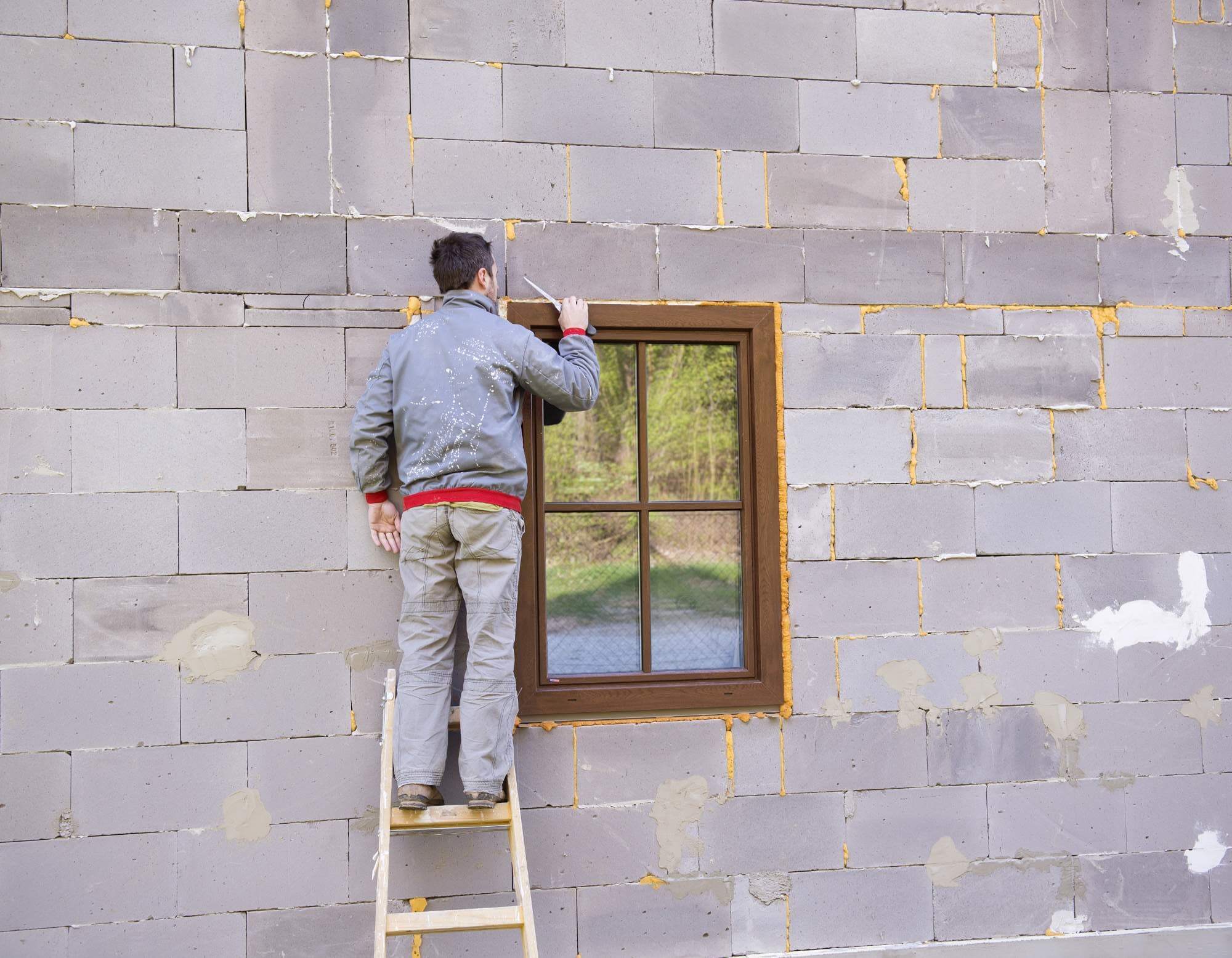
Man sealing window entry point to guard against termite infestation.
Routine Inspections: The Key to Early Detection
Scheduling routine inspections forms another essential preventative measure, especially if area prone heavy termite activity even after taking all precautions still possibility missed signs during initial checks thus regular professional inspections become indispensable part prevention strategy.
Note:If notice any suspicious changes like hollow sounding timber mud tubes darkening discoloration wood immediately call pest control expert evaluate situation before escalates full-blown infestation.
While DIY methods may seem cost-effective initially, to effectively get rid of termites it requires specialized knowledge from a licensed termite & the right equipment best left professionals who trained identify treat various types effectively without risking further damage property health hazards associated incorrect pesticide use.
For more information about professional termite treatment options visit this link: City Pests – Professional Termite Control Methods.
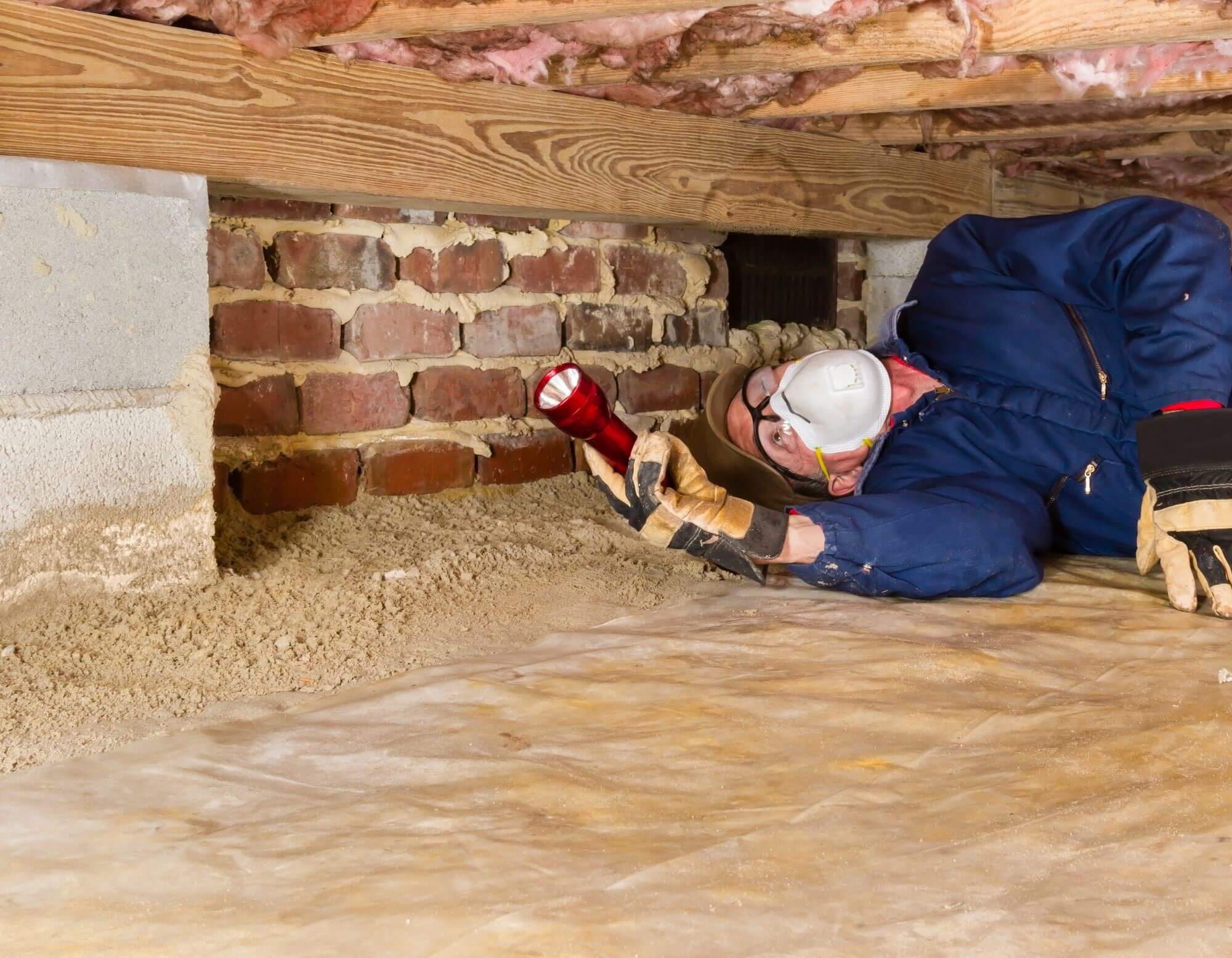
Termite specialist underneath home inspecting for signs of termite damage.
FAQ’s : Different Termites and What They Look Like
Can you tell me what termites look like?
Termites have straight antennae, a thick waist, and two pairs of wings that are equal in length. They range from white to light brown in color.
What are the different types of termites?
The common types include subterranean termites, Formosan termites, dampwood termites, drywood termites, and conehead termites. Each has unique characteristics based on habitat and behavior.
What are the 3 types of termites?
The three main categories are subterranean (live underground), drywood (inhabit dry wood), and dampwood (prefer moist environments) each with distinct features for identification.
What are the worst termites to have?
The most destructive species is typically the Subterranean termite due to its large colonies and aggressive feeding habits causing extensive damage over time.
All images on this page were sourced using Canva Pro
- What is a Termite Tower and How to Get Rid of Them
- Termite Retreatment Vs. Treatment Vs. Extermination
- Terminix Pricing Options: What They Can Do for You
- Pest Control vs. Termite Control
- Most Popular Termite Products on Amazon
- Most Expensive and Cheapest Pest Control Companies
- Leading Pest Control Companies in USA
- How to Choose the Ideal Pest Control Company
- How to Choose a Termite Exterminator Company
- Green Termite Traps: How They Work
- Early Termite Detection Signs
- Does Pest Control Include Termites?
- Do You Have To Leave Your House When Exterminating Termites
- Best Termite Prevention Options
- 13 Mistakes People Make When They Have Termites
- Termite Pictures – Images of Infestation
- Top Picks: Best DIY Termite Products On Amazon
- Insect Growth Regulator: Home Termite Control Solution
- How to Choose a Pest Control Company for Termites
- 8 Effective Organic Termite Control Options for Homeowners
